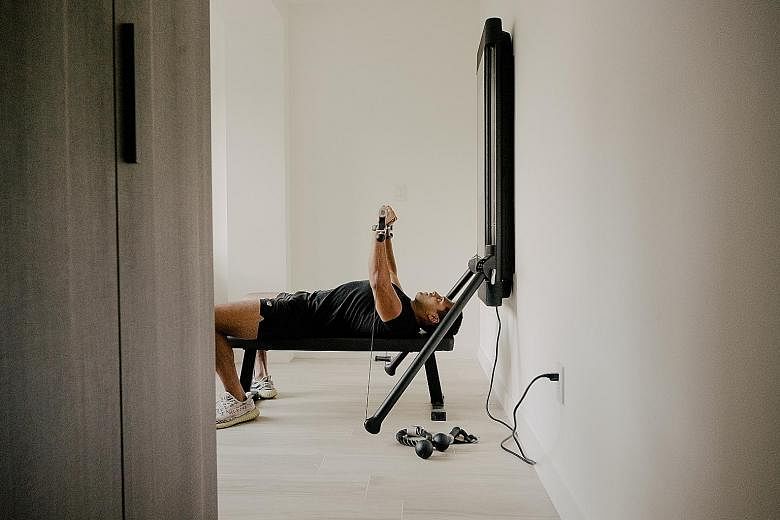NEW YORK • Since last year, Amay Sheth, a 26-year-old start-up founder in New York City, has been scheming to shave time off his visits to his parents and going less often. The reason: He cannot wait to get home to his Tonal, a US$2,995 (S$4,108) smart strength-training device that packs a weight room's worth of equipment in one machine that is the size of a poster.
"I hate being apart from it," said Sheth, who admitted to being obsessed with constantly smashing his strength score, which rises if he lifts a bit heavier or does more reps.
So obsessed that he recently bought a second Tonal for his parents' house, though there is an 11-week wait for delivery.
If that sounds like the scramble for Peloton, the Internet-connected stationary bike that has been a runaway sensation in the pandemic, that is exactly what Tonal and its competitors are hoping for: to make at-home strength training as popular as Peloton.
These would-be barbell juggernauts have some heavy lifting to do, though. Strength training has always had its adherents but has never achieved the mass devotion of cardio forms like Jazzercise, Tae Bo and, more recently, spinning.
A 2016 National Health Interview Survey - the most recent available - found that roughly half the population meets the standard for aerobic exercise set by the Centres for Disease Control and Prevention (150 minutes a week). But that just 21.9 per cent of women and 30 per cent of men meet guidelines for "muscle strengthening" (two sessions a week).
Weight rooms can be intimidating, with little that is intuitive about the equipment, and a fairly daunting array can be required for lifting at home. Nor does it help that aerobic exercise is considered the gold standard for calorie burning.
Some women seeking to slim down erroneously fear that lifting will cause bulk, but actually the more muscle you have, the more calories you burn, said Michele Olson, a senior clinical professor of sport science at Huntingdon College in Alabama and a fellow of the American College of Sports Medicine. By doing cardio, "most of us feel we've checked off our fitness for the day or week," she said.
One big advance of this new breed of devices is that, through a combination of artificial intelligence, cameras and motion sensors, they can actually teach you how to lift. They monitor your speed, telling you to "lower yourself down slower, and with control" during those curtsy lunges you tried to blast through, and point out errors in your form like "your knees are over your toes" for a squat.
Personal training is integral to all the machines: Tonal; Tempo, which came to market in February priced at US$1,995; and Forme Life, which costs $4,295.
"We've been running and cycling since we were kids, and when you take a studio class, the teachers are usually there to motivate us more than teach us," said Aly Orady, 42, Tonal's founder. "But strength training is actually really hard. That's why personal trainers have jobs."
Moawia Eldeeb, 27, founder of Tempo and a certified personal trainer, said his machine was an improvement on a trainer at the gym because of the data it offers.
"Before you can lift another five pounds, there's a lot of interesting data points that happen on the journey," said Eldeeb.
Instead of someone telling you that your form looks better, Tempo - a free-standing easel-shaped cabinet with a 42-inch screen - may show you, say, exactly how much deeper your squat has become.
Tonal is a screen with weighted cables tucked behind it; because it uses electromagnetic resistance, not physical weights, to generate force, it can act as a spotter, automatically decreasing weight when it senses a user is struggling.
Nearly 50 per cent of buyers are women, the founders say. And buyers of these devices, at least so far, seem to be people who already know how to lift weights, not people who first want to learn.
"The Tonal paid for itself in four months," said Joina Liao, 43, of San Francisco. She said her results from her personal trainer, who charged US$100 per session, were limited by how often she could afford him, but she can do Tonal sessions four times a week.
Liao has had a Peloton bike since 2015 but has ignored it since she bought the Tonal.
"If you take a dumbbell class in Peloton, you pick up the same weight as you've always done," she said. "With the AI in Tonal, once you do two sets, it goes up in one-pound increments. It really pushes you to improve without you putting much thought into it."
Niket Desai, 33, who works at an automated time-sheet start-up in San Francisco, bought a Tempo in January after he realised he was spending US$10,000 a year on Barry's Bootcamp classes.
He briefly debated a Peloton bike but decided he could motivate himself to do cardio; whereas he needed some help with the weight training. He rated the Tempo classes and challenges as "80 per cent of the quality of Barry's at one-tenth of the cost".
He said that seeing his friends' faces on the leader board and watching their rep counts and weight counts go up spurs him to use the machine. Desai lives in a small apartment; the Tempo cabinet takes up a chunk of his living room, but its design, he said, "makes it look like it belongs there".
Tonal and Forme - which look like a big screen and a mirror, respectively - also do not scream "gym".
NYTIMES

